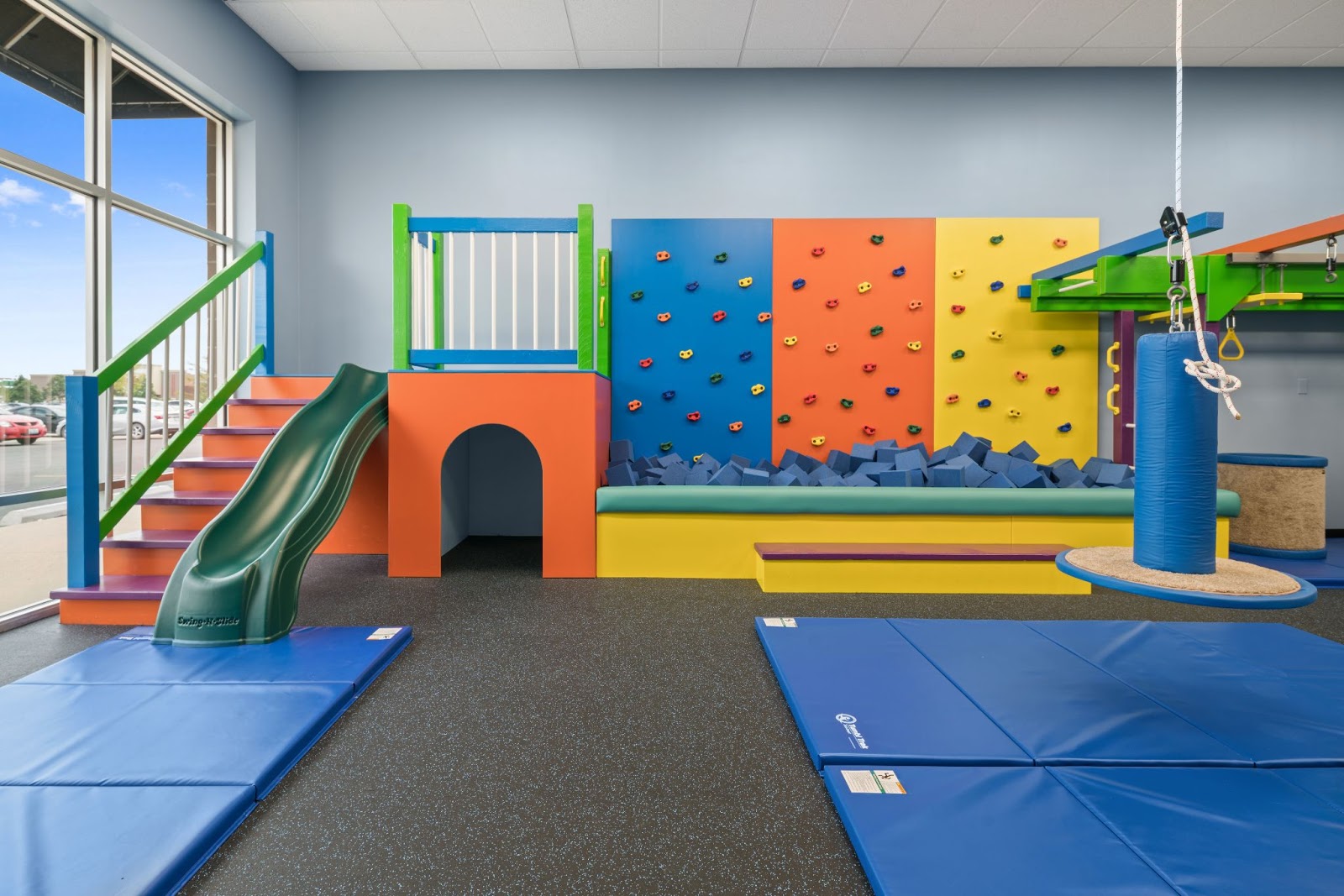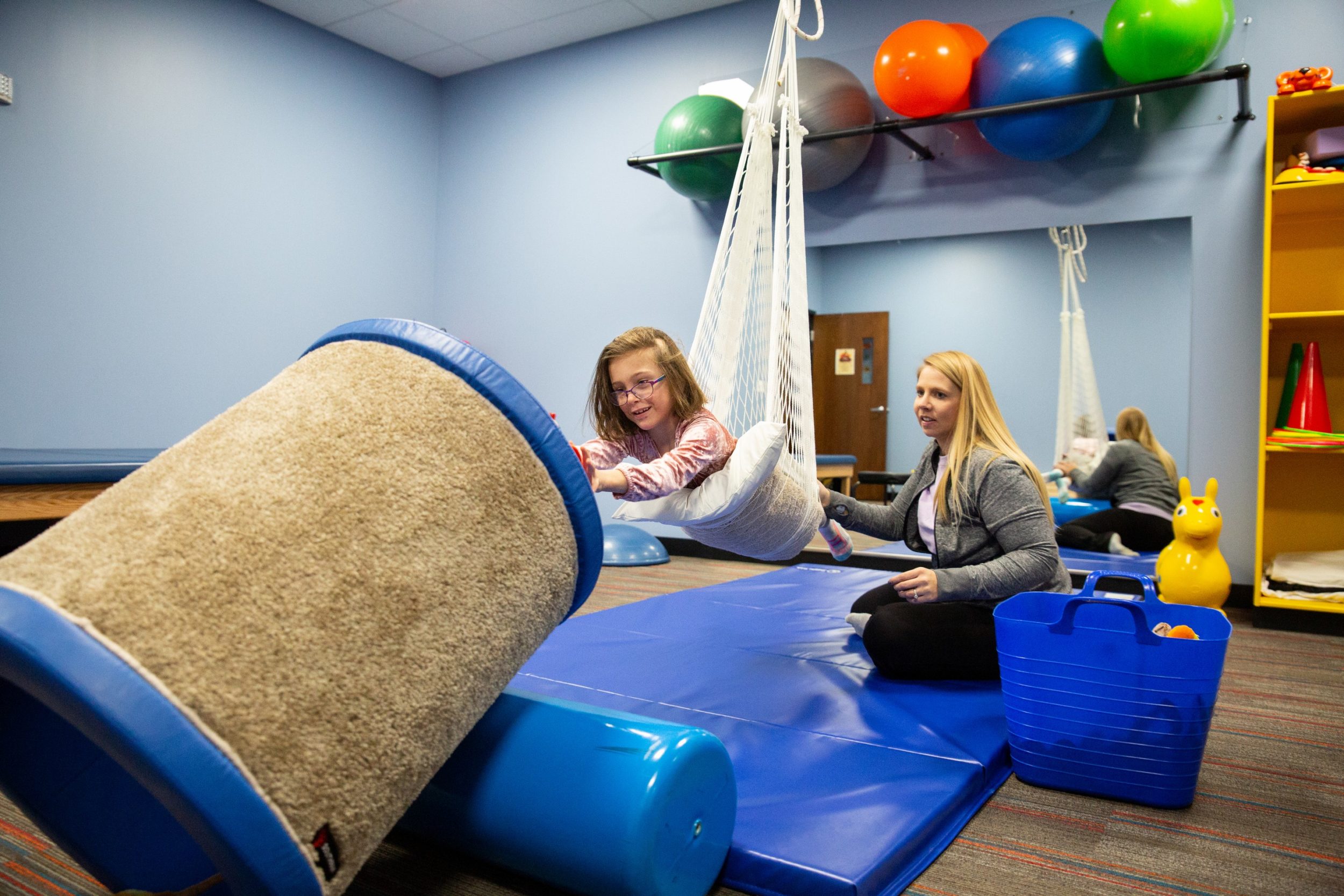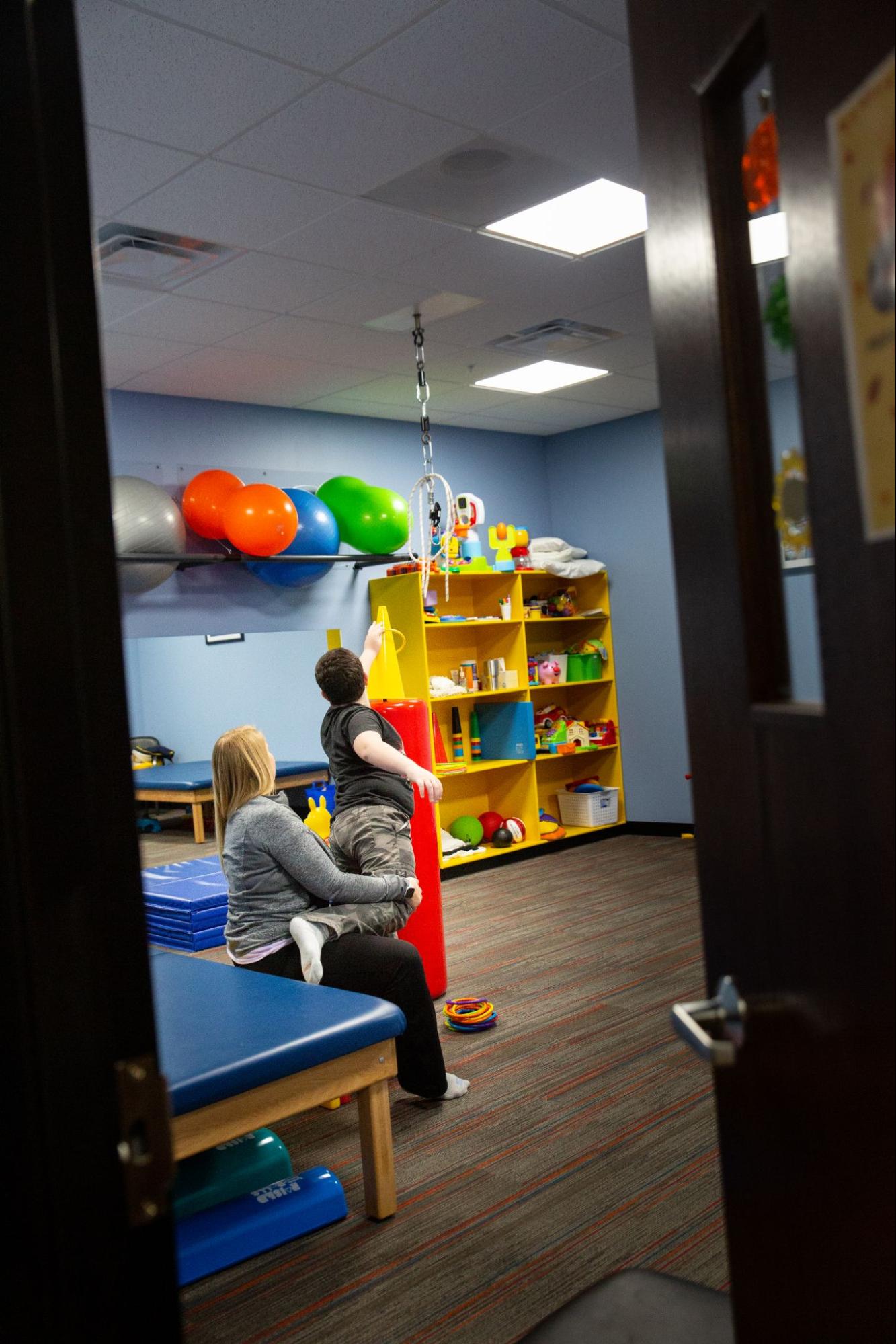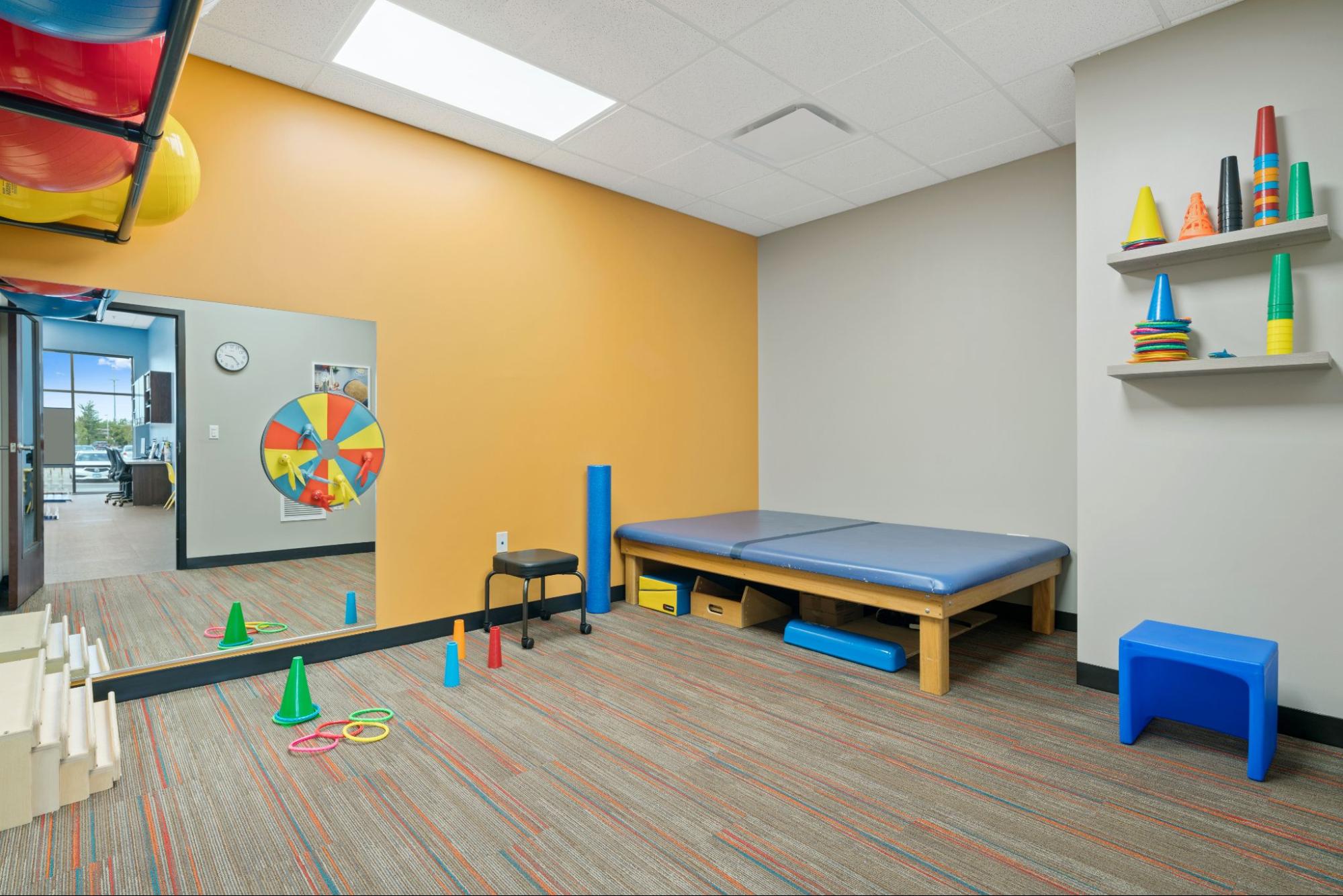Pediatric physical therapy sessions are designed to address each child’s individual needs. Physical therapy at Westside will help a child maximize their physical abilities and minimize their physical limitations.
Pediatric physical therapy will primarily help children who display delays or deficits in gross motor development, mobility, gait, strength and posture, or those with pain or injuries.
Much of the upcoming text is from a real physical therapy session at Westside. For privacy reasons, the child’s name, therapist’s name, Westside location will not be named. It is also important to remember that this is only what one session can look like and could be different from what another child’s program looks like, although there are often similarities.
The therapists at Westside strive to make therapy fun, as play is often incorporated into sessions. But at the same time, our therapists are dedicated to getting life-changing results for the children and their families and reach that through therapeutic intervention and finding a strong balance between therapy and play.
Pediatric physical therapy at Westside is very hands-on, and, like all disciplines, has a 1:1 therapist to child ratio. Sometimes it takes time for a child to get used to a therapist, which is why time is spent for the two to get to know each other early in the treatment process.

What is your child is being treated for in pediatric physical therapy?
The child has an abnormal gait which results in them not being able to walk the typical way (heel to toe) and generalized weaknesses where the child was falling on the playground or during play activities. Gait is a person’s pattern of walking that goes along with balance and coordination.
The pediatric physical therapy plan helps address how the child controls their lower leg “shank” (the part of the leg between the knee and ankle), or lower leg dynamically. It will also have the child learn to use their center of mass correctly and put it on their heels, rather than toes.
The child does a variety of exercises, some new and some older, that build lower leg strength, motor control, postural stability/control, core strength and encourage typical gait mechanics.
How did the pediatric physical therapy session start?
As mentioned above, this is just how one session began, but similarities with different variations may remain consistent across the clinic.
The child was able to pick a toy that they would play with on a surface — in this case a treatment table — while the therapist addressed their postural impairment, most notably at the lower leg. While the therapist mostly focuses on the most notable impairment, they make sure to address adjacent joints as they are all connected. Westside therapists try to keep therapy fun, but at the end of the day, physical therapy is hard work and therapists have a goal in mind they want to meet therapeutically.
With this activity, the child is asked to not lean or prop themself up using the table.
The therapist helped the child to load their leg without pushing their lower leg back to lock their knee into extension. At the same time, the therapist helped the child to work on their weight acceptance and minimize compensations used to stabilize the lower leg.
The therapist provides input through handling to inhibit these compensations, while also facilitating appropriate alignment and muscle recruitment. This child had limited use of their quadriceps and glutes, which forces them to overuse hamstrings and calf muscles, and/or adductors to stabilize. That is common among children with generalized weakness and gait abnormalities. These compensations become more prevalent if the patient does not accept weight properly and may also find other ways to take the weight off.
Therapists first build the foundations of the child’s postural system statically (not moving) to get proper alignment of the joints and body segments. With a stronger foundation, the patient is able to improve postural stability which is needed for quality mobility.
Pediatric physical therapy is very handling intensive, but over time the goal for this child and many others is to fade the input of the therapist. This means moving away from manual cueing and assistance to more tactile and verbal input.

How can gait abnormalities be treated in children?
Heel-toe taps
For anyone learning something new, it is always easier to break things down into smaller pieces. In this situation, to improve gait mechanics.
Typical walking involves a heel-to-toe pattern.
The child had one small mat in front of them and one behind. The child did heel and toe taps, which can help encourage a typical walking motion. The mats are there to act as targets.
- The child started with their toe on the target behind them
- They can then swing their leg through before extending their knee to tap their heel on the target in front of them.
This isolates the entire walking motion of the swing phase. This action is repeated numerous times to get blocked practice needed for learning a new motor plan.
The leg the child is standing on also practices the components of the stance phase of gait: weight transfer, knee extension over stable lower leg, and the ankle rocker (lower leg moving over foot).
For children receiving pediatric physical therapy, motor planning is sometimes a challenge and it can be difficult to put together multiple joint motions into a movement pattern. This is as true for gait and as it is for all other gross motor skills.
The patient progressed to this activity from just doing heel taps in isolation. Each component the child works on is a building block for the foundation of their motor pattern. The therapist incorporated play into the activity by having the mat be below the foot where the child was “making a pizza” or “making cookies” by “flattening the dough.”
Knee-bending exercises
The child had to bend their knees and leave their heels on the ground while squatting to work on the stability and control they have over their lower leg. Think of yourself squatting: Your best balance and strength has heels on the ground, (i.e. when you’re working out or athletic stance during sports).
The pediatric physical therapy exercise encourages the child to practice control over their ankle, foot, and lower leg needed for gait in the sagittal plane of motion (forward and backward motion). The child also had to work on making sure their knees did not move inward which addresses their ability to control their legs in the other two planes of motion.
Go back to thinking about yourself if you put your knees together while doing a squat workout. It will leave you unbalanced and in an unsafe position. Our therapists are always looking ahead to make sure nothing becomes an issue in the future.
The child had previously mastered the exercise, but had challenges this time. Our therapists will always treat what they see. If a child has an exercise mastered one week, but does not the following week, they will go back to getting it mastered again.
Belly/Back exercises
This child, as with many others, needed to work on their trunk stability and control in all planes of motion. Therapists utilize both core strengthening and core stabilization interventions to do this.
The child worked on moving from a seated position to a side plank position on a peanut-shaped exercise ball. The child must use their belly and back muscles eccentrically (muscles lengthening slowly) to lower themselves to the floor with control. While in a plank position, they were asked to grab a ring or toy to incorporate a play task.
This plank position is the core stabilization aspect of the activity. This involves using their belly and back muscles together to keep the trunk in alignment. The child will then come back up to a seated position where they work concentrically (muscles shortening) against gravity. The patient then places the ring on a cone or takes a few seconds to play with the toy they retrieved.
The child has muscle weakness in the oblique muscles.
The main goal of this pediatric physical therapy exercise is to strengthen the belly and back muscles, but it also helps the patient work on stabilizing the shoulder girdle (the muscles connecting the shoulder blade to the arm). The shoulder girdle strength is not a major goal in this patient’s program, but at Westside, the therapists treat the whole child.
If the child cannot hold his/herself up, then they would not be able to improve their core muscles, which is a more major goal. Everything is connected.
The ball is meant for support but also to add a dynamic component to it. The child had done the same activity on a stable foam block, but has now progressed.
Throughout the activity the physical therapist is providing input through handling on what muscles to use, what muscles not to use and what is the correct alignment or motion during each phase.

Importance of home exercises and team effort in pediatric physical therapy
Pediatric physical therapy is a team effort that includes the patient, their family, and their therapist(s). The best outcomes occur when that team works together towards a common goal.
Depending on each individual’s insurance and family schedule, a child may only have one visit to therapy per week, which makes doing home exercises crucial to a child’s progress and outcome. To put yourself in the child’s shoes, think about any goals you have had and how much work it took to achieve them.
The family members of the child’s therapy team can help them work towards their therapy goals more frequently. This makes them less difficult to achieve and the child will get better outcomes overall.
Our pediatric physical therapists will always spend a few minutes before or after sessions to talk about what was done and what can be done at home.
Stay tuned to our blog for more tips on why home exercises are important for your child’s growth and development in pediatric physical therapy.
In the meantime, if you have questions or want more information about Westside, call 815-469-1500, or click below to get started.







